Monica Marshall, a career woman, ends up getting custody of her niece, Winifred, after her mother, Monica’s sister, is murdered. Winifred’s father has been arrested for the deed and faces a death sentence, which is days away. Yet  Winifred claims he didn’t commit the crime. As a 9-year-old her opinions are dismissed by Monica, especially when she starts claiming to recognise various people at the mountain resort they are holidaying at; until of course strange and sinister events begin taking place which leave Monica in an injured state. Though it seems Monica is much more suspicious of the temporary resort manager. Or could he be her much needed ally? As Monica can only begin to imagine the danger she and Winifred are in…
Winifred claims he didn’t commit the crime. As a 9-year-old her opinions are dismissed by Monica, especially when she starts claiming to recognise various people at the mountain resort they are holidaying at; until of course strange and sinister events begin taking place which leave Monica in an injured state. Though it seems Monica is much more suspicious of the temporary resort manager. Or could he be her much needed ally? As Monica can only begin to imagine the danger she and Winifred are in…
Overall Thoughts
I would say this novel of suspense is made up of two parts. The first is concerned with Monica adapting to the new situation of becoming a guardian. This is not a role she was planning on, nor the initial ‘cold and dismissing’ tones of Winifred. Although I would say the reader is fairly in the middle with these two characters, not siding with either one, as on the one hand the reader can appreciate the difficult things Winifred has gone through and see her appealing qualities, and on the other hand the reader can equally see how Monica is wholly unprepared for these challenges and how she might naturally be sceptical of and pained by some of the things Winifred says. This loving but prickly relationship is what the first part of the narrative pivots on.
However, the second half of the story has a different centre, not only because of the change of scene back to Los Angeles where Winifred lived, but also because of the change in direction the plot takes. This moves the focus away from Winifred to a degree and focuses more on Monica and her ambiguous allies, as they try to tackle a much bigger problem than anticipated. Moreover, Monica has to deal with some unexpected shadows from her past, which are only hinted at in dribs and drabs at the start of the book, but which reach an explosive crescendo at the denouement of the tale.
An idea which grew on me as I read this book was the way initial impressions are highly deceptive in this story and whilst some are shed quite quickly, there are others which escape your notice, thus creating a greater shock when you realise what sort of person that character really is. I also think Hitchens uses a slower pace in the middle of the story in order to create a false of expectancy in the reader, within which the reader thinks they are in the lull before the storm, yet in this case the storm Hitchens delivers is far from the one the reader predicted. Perhaps in a more noir-y style the conclusion of the narrative is violently abrupt, but it feels like a very fitting ending nevertheless, for this quite cinematic story.
In reading this standalone tale by Hitchens I think I have seen a different side to her writing, as the only other novel I have read by her is one of her earlier D. B. Olsen novels, Cats Don’t Need Coffins (1946). In terms of settings the books are worlds apart, and I think today’s read has a more modern feel to it or perhaps in some ways is ageless. Though interestingly the cat theme lives on in this novel, as Monica has a cat which comes with them on their travels and is aptly named Boozer, given his predilection for drinking people’s alcohol. I have one more Hitchens read to go, more on that later, and I am intrigued to see where my Hitchens reading takes me next…
Rating: 4.25/5
Source: Review Copy (Stark House)
Calendar of Crime: July (5) Other July Holiday
One more slightly alarming thing, for me anyways, is that Monica describes herself as an old maid. She’s 29….
I quite agree about “old maid”. Le mot juste is “spinster”.
LikeLike
[…] Baskervilles in Terror Lurks in Darkness (1953), and delivers an intriguing on-the-run-thriller in Stairway to an Empty Room […]
LikeLike
[…] Stairway to an Empty Room (1951), Hitchens provided a revamped and grittier heroine in jeopardy suspense tale and in […]
LikeLike
[…] Stairway to an Empty Room (1951) […]
LikeLike